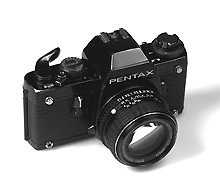The Pentax LX

When I started my current series in Photon series on today's professional
35mm SLRs the Pentax LX was one of the cameras on my list. Alas...
events have overtaken my plans, as it transpires that the LX ceased to be
a "current" model late last year. However, being of a somewhat
stubborn nature, this reviewer carries on regardless.
History
The Pentax LX first saw the light of day - after many years in development
- in 1980, hot on the heels of the similarly specified Nikon F3. It caused
quite a stir at the time but faded into relative obscurity thanks to Nikon's
domination of its target markets (Canon had yet to establish their current
position) and the fact that Pentax themselves scarcely admitted to its existence.
To my memory and knowledge, no advertisement for the LX ever appeared in
the UK throughout its 15 year lifespan. When introduced an LX cost a staggering
£300 (£50 less than an F3) but, by the time of its demise in November
1995, had risen to £1,530 - a 510% increase - and by then more than
even the F3/T. By this time LXs were available only as a special order item,
thereby ensuring their end. After all, imagine walking into your dealer
only to be told they'll take your cash - but you'll have to wait 'til they
knock one together by hand for you in Japan
Right, so why is the LX, a crusty old relic of 1970s design, still worth
writing about even after its official death? Firstly, and most importantly,
I've just bought one and am hereby attempting to raise its re-sale value.
No... seriously, it has a number of features which make it quite unique
for use by the serious technophobic photographer. For a start they are almost
ridiculously tough and reliable, being made from light but strong aluminium
alloy. Typical of Pentax SLRs of the 1980s, the LX is slim, compact and
of a functional and austere design.
Despite its rather mundane appearance it has some rather special attributes
which make it a unique photographic tool. Foam seals and gaskets are fitted
at various points to keep out water and dust. Even after many years of use
the LX remains capable of functioning under extreme environmental conditions,
no mean feat for a camera with interchangeable viewfinders.
Finders
No matter which of the six finders you choose, all TTL metering and viewfinder
display functions are maintained. In addition all finders display the same
image area, very close to 100% of the actual frame. Of these finders, three
are standard prisms, the FA-1 (standard issue), FA-1W (extended dioptre
correction range) and FA-2 (a light and compact, "stripped to the bone"
prism). Two are waist level finders, the FF-1 (standard WLF) and the FE-1
(magni-finder). The last is the highly desirable, and expensive, FB-1 system
finder; a 45° prism which accepts a choice of three attachments which
allow corrected viewing at various angles. For general photography the FA-1
is an excellent choice and can simply be removed for waist level viewing
without any detrimental effect on metering or focusing.
LX focusing screens are bright and even, and there was a choice of twelve
to cover all general and scientific uses. Pentax MX screens can also be
used, although they are less bright. A sophisticated IDM SPD metering cell
in the camera body reads manual exposures through the large semi-silvered
mirror, and AE and TTL flash directly from the film plane during exposure.
Metering is of a lower centre weighted pattern which proves very accurate
for the majority of subjects.
Speeds
In manual mode the LX has shutter speeds from 1/2,000 to 4 seconds and in
aperture priority p; its sole auto mode p; will expose down to an
astonishing EV minus 6.5, which translates to 125 seconds at 1.2 with 100
ISO film. This is half a stop more sensitive than Canon's often-quoted record
of EV minus 6 for an unboosted TTL metering system. Flash sync is rather
pathetic by modern standards at 1/75. The shutter is a hybrid electronic
and mechanical design, speeds of 1/60 and below being electronically timed
and speeds from X to 1/2,000 being mechanically timed in manual mode, allowing
relatively unhindered use even in the event of battery failure. Film speeds
from 6 to 3200 can be set on a well designed dial below the rewind crank.
The exposure counter is yet another feature which is unique to the LX as
it counts with absolute precision in both directions. Impressive but pointless?
Not quite. It is so designed that multiple exposures can be made by winding
back to any given frame in perfect register. Film loading uses Pentax's
own "magic needle" system p; by far the simplest, quickest
and most positive method I have come across.
Conclusion
Overall, the LX exudes quality, all controls are smooth and positive - an
uncommon combination - and, even without grips or winders, handling is good.
A comprehensive range of accessories was produced for the LX, making it
one of the most versatile system cameras ever made. These include a 5fps
motordrive, winder, databacks, bulk back, wired and wireless remote control
systems, TTL flashguns, various macro devices and, of course, access to
a wide selection of generally superb lenses.
An LX body with an FA-1 finder will cost anywhere between £400 and
£700 in the UK depending on condition. Used Pentax KM and KA lenses
tend to be considerably less expensive than Nikon equivalents and, in my
own experience, every bit as good. Although the LX never fully caught on
with professional photographers, it makes an excellent basis - combined
with an MX or K1000 as a second body and a choice of lenses from 15mm to
2000mm - for a versatile and relatively affordable professional quality
SLR system.
Return to Photon May 96 contents
